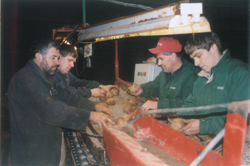
Features
Production
Research
Potato belt farm struggles with lack of markets
struggles with lack of markets
April 22, 2008 By Kathy Birt
Growing potatoes in what is termed
the “potato belt” of Prince Edward Island has provided a good living
for the Waugh family as far back as the 1920s. But the excess of
potatoes across North America in the 21st century may have them
planting in blind faith.
 |
| These spuds, grown in the potato belt of P.E.I., are carefully inspected by the Waugh family in Bedeque. (Left to right) Brothers Gordon, Ronald and Allan work along with Gordon’s son, Andrew. (Photo by Kathy Birt) |
Growing potatoes in what is termed the “potato belt” of Prince Edward Island has provided a good living for the Waugh family as far back as the 1920s. But the excess of potatoes across North America in the 21st century may have them planting in blind faith.
Willard Waugh came to the Bedeque-area farm in 1945 when his father, Robert, was retiring. “We used to have livestock but began easing out of that about 20 years ago,” he explained.
Through the years, Willard says the potato industry has been good to the family. “We used to ship to South America and Europe not that long ago. In the early 1990s, we were making money growing and shipping potatoes.”
As recently as eight years ago, the Waugh family shipped potatoes to Switzerland, which was suffering a shortage at the time.
But since then, Willard has seen markets for P.E.I. potatoes disappear. While the nearby port city of Summerside used to have one of the largest shipping ports in North America, Willard said only one ship of potatoes left the port last fall.
Willard’s sons Gordon, Ronald and Allan consider themselves stewards of the land and work to keep the land fertile and the natural waterways on the property protected. Gordon’s 25-year-old son, Andrew said the family completed an Environmental Farm Plan with some assistance from the government and have implemented diversion terraces and strip cropping. The land is protected through the growing of hay and barley in rotation with their potato crop; the soil is mulched with hay to prevent or decrease soil
erosion.
“We had a loss of acreage by building in new ditches and dikes,” Andrew said. “The ponds and streams are naturally there and some have trout in them. We worked to protect the natural habitat.”
So, with a series of crises in the industry behind them (potato wart, a drought and a glut of potatoes on the market in the winter of 2003/2004) and seeming to have all their farming practices going in the right direction, the potato growers took a chance in the spring of 2004 and planted 500 acres of spuds, the same amount they had planted in 2003. They made this decision despite the fact that growers Island-wide “dumped” 100 million pounds of potatoes during February and March 2004.
“Looking back, we should have (planted) less,” noted Gordon.
His comment seems even more poignant considering the recent news that P.E.I. growers are being urged toward another potato “dump” this year.
“Theoretically, it’s an individual decision (to dump),” said Gordon.
But that personal decision is being encouraged through Island-wide meetings between growers and the P.E.I. Potato Board. As a result of these meetings, some Island growers have voluntarily agreed to dump 400,000 hundredweight (cwt) in an effort to drive up the North American price.
Ivan Noonan, general manager of the P.E.I. Potato Board, says he is very pleased with the results of the number of pledges coming in from growers and, with the weather having turned mild, some farmers are already out spreading potatoes on their land. “We have projected 150 million pounds to be dumped and I urge all growers to divert,” he said. “If a grower has open potatoes and waits for others to divert, that grower reaps the benefits and this is not about the individual; it’s about the industry.”
Some of the potatoes aimed for diversion will go to local food banks on P.E.I. while a few dealers have agreed to buy what they need from growers who agree to divert.
“To make the system work, there will be a certain percentage that will have to be gotten rid of,” said Gordon. “But even with that, there is no guarantee that prices will go up.”
Growing their 500 acres for processing, seed and table stock, the brothers have contracts with Cavendish Farms and McCains. Even so, returns are not gauranteed. “Contract prices may seem fair at the time of negotiating, but our prices for production keep going up,” said Gordon, adding that prices this winter are no higher than they were a year ago.
Willard expects the family will have a hard time marketing the 125 acres of potatoes produced on the farm without a contract. “Buyers are bringing in potatoes from New Brunswick and the U.S. when we have a good supply on P.E.I.”
He points out that the 500 acres grown on their land is not just to support one family.“There’s five families living out of that.”
Allan says he believes the crisis in the industry is as simple as supply and demand. He believes if the federal government were to offer assistance to growers now, it wouldn’t solve the glut problem. “Federal dollars create more supply, not demand. There needs to be some kind of demand for North American farmers to grow less potato.”
Gordon says he feels farmers should work to solve the issue of too many potatoes. “Farmers need to come together and collectively bond as a group to figure out the amount of potatoes the market needs.”
“The next crop to be planted will need more planning,” said Willard. “Growers need to have their markets established, before they plant.”
Print this page